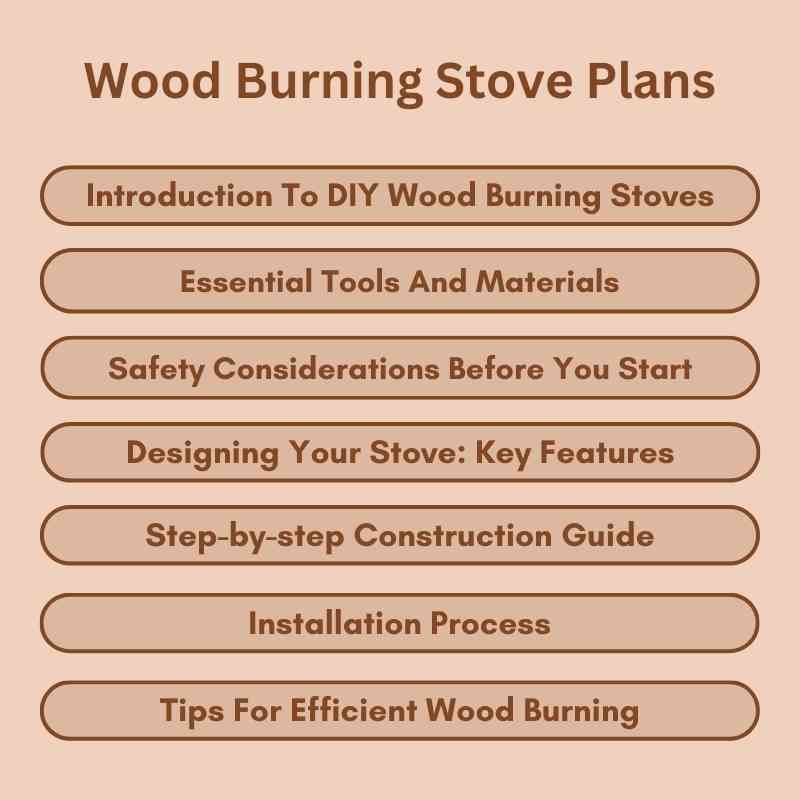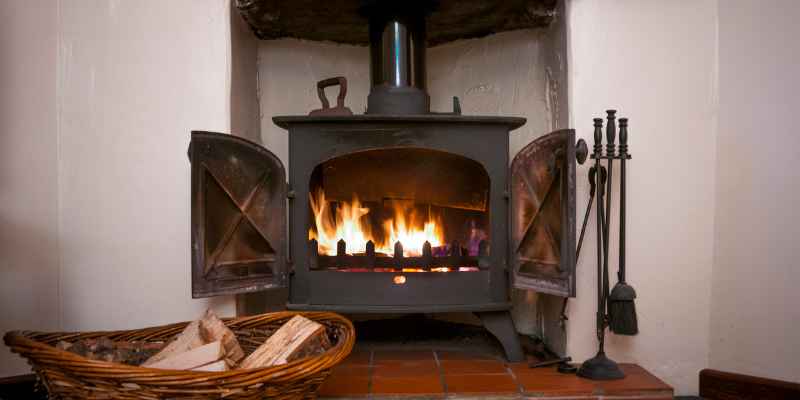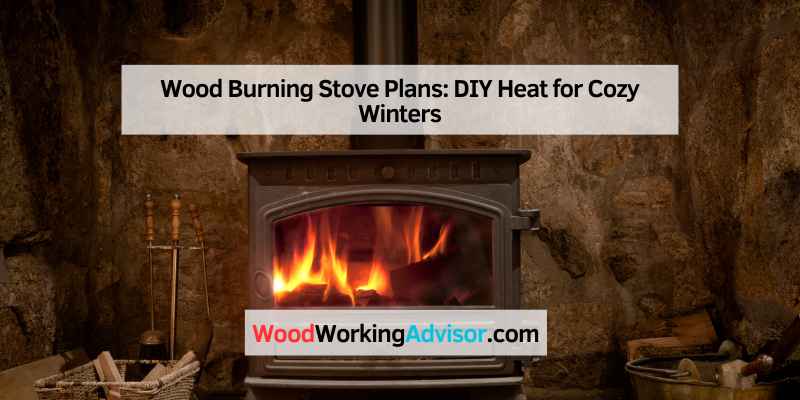Wood burning stove plans provide essential guidance for building or installing an efficient heating solution. These plans include detailed designs, material lists, and safety tips.
Wood burning stoves are an excellent way to heat your home while enjoying the charm of a traditional fire. They offer efficiency and cost savings, making them a popular choice among homeowners. With the right plans, you can create a stove tailored to your specific needs and space.
Understanding your options will help you choose the best design, whether you’re looking for a rustic aesthetic or a modern finish. Safety is crucial, so following proper guidelines ensures a safe installation. Explore various designs and features to find the perfect wood burning stove plan for your home.
Introduction To DIY Wood Burning Stoves
Creating a DIY wood burning stove can be a rewarding project. It offers warmth, comfort, and a cozy atmosphere. Building your stove allows for customization to fit your space. Plus, it can save money on heating bills.
Why Choose A Wood Burning Stove?
Wood burning stoves provide many benefits. Here are some key reasons to consider:
- Cost-effective heating: Wood is often cheaper than other fuels.
- Environmentally friendly: Wood is renewable and carbon-neutral.
- Independence: No reliance on electricity or gas supplies.
- Ambiance: Enjoy the natural glow and crackling sound of fire.
The Rise Of DIY Heating Solutions
More people are choosing DIY heating solutions today. This trend reflects a shift in consumer habits. Here’s why DIY wood burning stoves are gaining popularity:
- Customization: Tailor your stove to meet specific needs.
- Learning experience: Gain skills in woodworking and design.
- Community: Join a growing network of DIY enthusiasts.
- Cost savings: Build a stove for less than buying one.
DIY wood burning stoves allow for creativity and practicality. They can enhance any living space while being functional. This trend continues to grow as more people seek unique heating solutions.

Essential Tools And Materials
Building a wood burning stove requires careful planning. Choosing the right tools and materials is key. This section covers the essential items needed for your project.
Tools Needed For The Job
- Measuring Tape: For accurate measurements.
- Level: Ensures everything is even.
- Saw: A circular or miter saw works best.
- Drill: Use for making holes and driving screws.
- Wrench Set: For tightening bolts and nuts.
- Safety Gear: Wear gloves and goggles for protection.
Selecting The Right Materials
Choosing the right materials is crucial for safety and durability. Here are the main components to consider:
| Material | Description |
|---|---|
| Steel | Strong and durable for the stove body. |
| Fire Bricks | Insulate and protect against high heat. |
| Insulation Board | Helps retain heat and improve efficiency. |
| Flue Pipe | For smoke ventilation to the outside. |
| Door Gasket | Ensures a tight seal for safety. |
Always prioritize quality over cost. Durable materials ensure your stove lasts longer.
Safety Considerations Before You Start
Building a wood burning stove requires careful planning. Safety must be the top priority. Ignoring safety can lead to serious accidents. Follow these guidelines to ensure a safe setup.
Fire Safety Protocols
Fire safety is crucial for any wood burning stove project. Follow these protocols:
- Keep flammable materials away from the stove.
- Use fire-resistant materials for construction.
- Install a smoke detector nearby.
- Have a fire extinguisher on hand.
- Check local fire codes and regulations.
Regular maintenance is vital. Clean the stove and chimney often. Check for cracks or damage. Ensure the stove operates efficiently.
Ventilation Requirements
Proper ventilation is essential for safety and efficiency. Here are key points:
| Ventilation Type | Description |
|---|---|
| Direct Vent | Allows fresh air intake and exhaust outside. |
| Natural Vent | Uses chimney to vent smoke outside. |
| Power Vent | Uses a fan to push exhaust outdoors. |
Ensure the room has enough air circulation. Open windows or use vents if needed. This prevents dangerous gas buildup.
Designing Your Stove: Key Features
Creating a wood burning stove requires careful planning. Focus on essential features to ensure efficiency and safety. Below are key considerations for your stove design.
Determining Size And Capacity
Choosing the right size and capacity is crucial. Consider the following:
- Room Size: Measure your space. Larger rooms need bigger stoves.
- Heating Needs: Calculate how much heat is required.
- Wood Type: Different woods burn differently. Choose accordingly.
Use this table to help determine your stove size:
| Room Size (SQ FT) | Stove Size (BTU) |
|---|---|
| 500 | 15,000 – 20,000 |
| 1,000 | 20,000 – 30,000 |
| 1,500 | 30,000 – 40,000 |
Incorporating Efficient Airflow
Efficient airflow is vital for optimal burning. Consider these features:
- Air Vents: Position them for maximum airflow.
- Draft Control: Use adjustable draft to control burn rate.
- Secondary Combustion: Add a system for cleaner burns.
Efficient airflow improves heat output and reduces smoke. It also enhances the lifespan of your stove.
Step-by-step Construction Guide
Building a wood burning stove can be rewarding. This guide provides clear steps. Follow these instructions for a successful project.
Building The Firebox
The firebox is the heart of your stove. It contains the flames. Use heat-resistant materials for safety. Follow these steps:
-
- Gather materials: steel plates, welding tools, and firebricks.
- Cut the steel plates to size:
| Part | Dimensions (inches) |
|---|---|
| Bottom | 24 x 20 |
| Sides | 24 x 18 (x2) |
| Back | 20 x 18 |
| Front | 24 x 18 |
| Top | 24 x 20 |
- Weld the pieces together for strength.
- Line the interior with firebricks for insulation.
Ensure all joints are secure. This prevents heat loss. Check for gaps. A well-built firebox enhances efficiency.
Assembling The Stove Body
The stove body houses the firebox. It also directs heat. Follow these steps for assembly:
- Use the same steel plates for the body.
- Construct the frame:
- Weld the bottom plate to the sides.
- Add the back plate securely.
- Attach the front plate with a door.
- Install the top plate, ensuring proper fit.
- Drill holes for ventilation:
- Two holes on the sides.
- One hole at the back for the chimney.
- Ensure the body is level and stable.
Check for sharp edges. Smooth them out for safety. Your wood burning stove is taking shape!
Installation Process
Installing a wood burning stove requires careful planning and execution. Proper installation ensures safety and efficiency. Follow these steps for a successful setup.
Preparing The Installation Site
Choosing the right location is crucial. Consider these factors:
- Distance from flammable materials
- Access to a chimney
- Level and stable flooring
Follow these steps to prepare your site:
- Clear the area of debris and clutter.
- Measure the space for the stove.
- Check local building codes.
- Install a non-combustible hearth pad.
Ensure proper ventilation. It helps in efficient burning.
Securing The Stove Safely
Securing your wood burning stove is essential for safety. Here’s how to do it:
- Use brackets to attach the stove to the wall.
- Seal any gaps with fire-resistant materials.
- Connect the chimney pipe securely.
Follow these tips for a safe installation:
| Step | Description |
|---|---|
| 1 | Level the stove with shims if needed. |
| 2 | Ensure the chimney is properly aligned. |
| 3 | Test the stove for stability and safety. |
Check for proper clearance around the stove. This prevents fire hazards.
Tips For Efficient Wood Burning
Efficient wood burning is essential for warmth and savings. Proper techniques improve heat output and reduce smoke. Here are some tips to enhance your wood burning experience.
Choosing The Right Wood
Choosing the best wood is crucial. Different types of wood burn differently. Here’s a quick guide:
| Wood Type | Burn Quality | Seasoning Time |
|---|---|---|
| Hardwoods | Long-lasting heat | 6-12 months |
| Softwoods | Quick to ignite | 3-6 months |
| Oak | High heat output | 12-24 months |
| Pine | Good for kindling | 3-6 months |
Hardwoods like oak provide great heat. Softwoods ignite quickly but burn faster. Always use seasoned wood. Seasoned wood has less moisture. This means better heat and less smoke.
Maintenance For Optimal Performance
Regular maintenance keeps your stove efficient. Follow these steps:
- Clean the flue: Do this at least once a year.
- Check gaskets: Ensure they seal properly.
- Inspect the chimney: Look for blockages or creosote buildup.
- Remove ashes: Empty ashes regularly to improve airflow.
Inspect your stove often. Look for rust or damage. Replace parts as needed. A well-maintained stove burns more efficiently. Save money and enjoy cozy warmth.
Accessories And Customizations
Enhancing your wood burning stove can make a significant difference. Accessories and customizations improve functionality and aesthetics. Here are some popular options to consider.
Adding A Cooking Surface
Cooking on a wood burning stove can be fun and efficient. A cooking surface allows you to prepare meals while enjoying the warmth. Here’s how to add one:
- Cast Iron Grates: Durable and excellent for heat retention.
- Flat Top: A smooth surface for pots and pans.
- Side Attachments: Expand cooking space without crowding.
Benefits of a cooking surface:
- Versatile cooking options.
- Saves on electricity bills.
- Creates a cozy cooking environment.
Decorative Enhancements
Customizing your wood burning stove adds charm and personality. Decorative enhancements can be functional and stylish.
- Tile Surround: Adds color and protects walls.
- Wood Storage: Integrated racks for easy access.
- Custom Paint: Personalize the look to match your decor.
Consider these popular materials:
| Material | Benefits |
|---|---|
| Stone | Durable and heat-resistant. |
| Metal | Modern look and easy to clean. |
| Wood | Warmth and natural appeal. |
Choose accessories and customizations that fit your style. Enjoy your wood burning stove to the fullest!
Legal And Environmental Considerations
Building a wood burning stove requires careful thought about legal and environmental issues. Understanding local laws and their impact helps ensure safe and responsible use.
Understanding Local Regulations
Local regulations can vary widely. Check the following:
- Building codes
- Fire safety laws
- Air quality standards
Some regions have specific requirements for:
- Type of stove
- Installation methods
- Emissions controls
Consult your local government or fire department. They provide guidance on compliant designs and installations. Non-compliance can lead to fines or safety hazards.
Minimizing Environmental Impact
Using a wood burning stove has environmental effects. Here are ways to reduce your impact:
- Choose an EPA-certified stove. These stoves burn cleaner.
- Use seasoned wood. It burns more efficiently.
- Ensure proper ventilation. This reduces smoke and emissions.
Consider the following table for a quick comparison:
| Wood Type | Moisture Content | Burn Efficiency |
|---|---|---|
| Seasoned Oak | 20% | High |
| Green Pine | 50% | Low |
| Seasoned Birch | 25% | Medium |
Regular maintenance keeps your stove running efficiently. Schedule annual inspections to check for buildup. This helps improve air quality.
Real-life Examples And Success Stories
Seeing real-life examples of wood burning stove projects can inspire many. These success stories showcase creativity and resourcefulness. Each project highlights unique designs and practical solutions. Let’s explore some remarkable case studies and lessons learned from the DIY community.
Case Studies Of DIY Stove Builders
Many DIY builders have shared their experiences. Here are a few notable case studies:
| Builder | Project Type | Materials Used | Outcome |
|---|---|---|---|
| John Smith | Traditional Cabin Stove | Reclaimed Steel, Bricks | Efficient heating, rustic charm |
| Emily Johnson | Modern Minimalist Stove | Stainless Steel, Glass | Sleek design, high efficiency |
| Mike Brown | Portable Camping Stove | Aluminum, Wood | Lightweight, easy to transport |
These builders transformed their visions into functional stoves. Each project demonstrates the power of creativity and hard work.
Lessons Learned From The DIY Community
The DIY community offers valuable insights. Here are key lessons learned:
- Planning is essential: Create detailed blueprints.
- Safety first: Use protective gear and follow guidelines.
- Choose the right materials: Ensure durability and efficiency.
- Seek advice: Join forums and talk to experienced builders.
- Test before use: Always check for leaks and proper airflow.
These lessons can help future builders succeed. Learning from others saves time and effort.
Conclusion: Embracing The DIY Spirit
Building a wood burning stove is a rewarding adventure. It sparks creativity and fosters self-reliance. Every step brings you closer to a cozy home. Let’s explore the rewards of this DIY journey.
The Satisfaction Of Self-sufficiency
Creating your own wood burning stove offers immense satisfaction. Here’s why:
- Skill Development: Gain valuable hands-on skills.
- Cost-Effective: Save money compared to buying a new stove.
- Customization: Design it to fit your specific needs.
- Sustainability: Use eco-friendly materials and methods.
Every moment spent working on your project builds confidence. You transform raw materials into something functional and beautiful. That sense of achievement is unmatched.
Encouragement To Start Your Project
Ready to dive into your wood burning stove project? Here are some tips to get started:
- Research: Gather plans and ideas online.
- Gather Materials: Make a checklist of needed supplies.
- Set a Timeline: Plan your project timeline realistically.
- Ask for Help: Don’t hesitate to reach out to experienced DIYers.
- Enjoy the Process: Embrace each moment of your creation.
Starting a DIY project can seem daunting. Break it down into manageable tasks. Celebrate each small victory along the way. Your hard work will pay off with a functional stove.
Embrace the DIY spirit. Enjoy the journey of creating something uniquely yours.

Frequently Asked Questions
What Are The Benefits Of A Wood Burning Stove?
Wood burning stoves provide efficient heating and can reduce energy costs. They also create a cozy atmosphere, enhancing your home’s ambiance. Additionally, using wood as a fuel source is often more sustainable than fossil fuels. This makes them an eco-friendly heating option for many households.
How Do I Choose The Right Wood Burning Stove?
Selecting the right wood burning stove depends on your space and heating needs. Consider factors like size, efficiency, and design. Look for models with high energy ratings and safety certifications. Consulting with a professional can help ensure you make an informed decision that fits your home perfectly.
Can I Build My Own Wood Burning Stove?
Yes, you can build your own wood burning stove with proper plans and materials. However, ensure that you follow local building codes and safety guidelines. Use quality materials to ensure durability and efficiency. Research thoroughly and consider seeking expert advice to avoid potential hazards.
How To Maintain A Wood Burning Stove?
Regular maintenance of your wood burning stove is crucial for safety and efficiency. Clean the flue and chimney at least once a year. Check seals and gaskets for wear and replace them as needed. Regularly removing ash and debris will help maintain optimal performance and longevity.
Conclusion
Creating your own wood burning stove can be a rewarding project. It allows for customization and can enhance your home’s warmth. With the right plans, you can ensure safety and efficiency. Dive into your project with confidence, and enjoy the benefits of a cozy, sustainable heating option.
Happy building!

